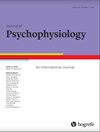识别不一致效应的来源
IF 0.9
4区 心理学
Q4 NEUROSCIENCES
引用次数: 0
摘要
摘要在日常生活中,面部和身体发出的情绪信号通常被视为一个整体。先前的研究揭示了一种不一致效应,它指的是对情绪一致和不一致的脸-身体复合物的不同行为和神经反应。然而,究竟是哪一种“脸-体”化合物引起了不一致效应尚不清楚。在本研究中,我们加入中性面孔和中性身体刺激,形成新的脸-体复合物。40名视力正常或矫正至正常的受试者参加了本实验。通过比较具有情绪冲突的脸身复合物和具有中性刺激的脸身复合物,我们可以探讨不一致效应的来源。对于行为和事件相关电位(ERP)数据,采用2(身体表情:快乐、恐惧)× 2(一致、不一致)重复测量方差分析(ANOVA)来重新调查不一致效应,并采用3(面部表情:恐惧、快乐、中性)× 3(身体表情:恐惧、快乐、中性)重复测量方差分析(ANOVA)来澄清不一致效应的来源。正如预期的那样,行为和ERP结果都成功地重复了不一致效应。具体而言,行为数据显示情绪上一致的面部-身体复合物比不一致的面部-身体复合物更准确地被识别(p < 0.05)。N2的ERP分量受面部和身体表情的情绪一致性的调节,结果表明情绪不一致的化合物比情绪一致的化合物激发出更大的N2振幅(p < 0.05)。P1和P3成分未发现不一致效应(p = 0.079, p = 0.99)。此外,通过将情绪不一致的配对与中性基线进行比较,本研究表明,不一致效应的来源可能来自快乐-恐惧的身体化合物。我们推测,恐惧身体所表达的情绪比快乐身体所表达的情绪要强烈得多,因此对面部表情的判断产生了更强的干扰。本文章由计算机程序翻译,如有差异,请以英文原文为准。
In Identifying the Source of the Incongruent Effect
Abstract. Emotional signals from the face and body are normally perceived as an integrated whole in everyday life. Previous studies have revealed an incongruent effect which refers to distinctive behavioral and neural responses to emotionally congruent versus incongruent face-body compounds. However, it remains unknown which kind of the face-body compounds caused the incongruence effect. In the present study, we added neutral face and neutral body stimuli to form new face-body compounds. Forty subjects with normal or corrected-to-normal vision participated in this experiment. By comparing the face-body compounds with emotional conflict and face-body compounds with neutral stimuli, we could investigate the source of the incongruent effect. For both behavioral and event-related potential (ERP) data, a 2 (bodily expression: happiness, fear) × 2 (congruence: congruent, incongruent) repeated-measure analysis of variance (ANOVA) was performed to re-investigate the incongruent effect and a 3 (facial expression: fearful, happy, neutral) × 3 (bodily expression: fearful, happy, neutral) repeated-measure ANOVA was performed to clarify the source of the incongruent effect. As expected, both behavioral and ERP results have successfully repeated the incongruent effect. Specifically, the behavioral data showed that emotionally congruent versus incongruent face-body compounds were recognized more accurately ( p < .05). The ERP component of N2 was modulated by the emotional congruency between the facial and bodily expression showing that the emotionally incongruent compounds elicited greater N2 amplitudes than emotionally congruent compounds ( p < .05). No incongruent effect was found for P1 or P3 component ( p = .079, p = .99, respectively). Furthermore, by comparing the emotionally incongruent pairs with the neutral baseline, the present study suggests that the source of the incongruent effect might be from the happy face-fearful body compounds. We speculate that the emotion expressed by the fearful body was much more intensive than the emotion expressed by the happy body and thus caused a stronger interference in judging the facial expressions.
求助全文
通过发布文献求助,成功后即可免费获取论文全文。
去求助
来源期刊

Journal of Psychophysiology
医学-神经科学
CiteScore
2.60
自引率
7.70%
发文量
25
审稿时长
>12 weeks
期刊介绍:
The Journal of Psychophysiology is an international periodical that presents original research in all fields employing psychophysiological measures on human subjects. Contributions are published from psychology, physiology, clinical psychology, psychiatry, neurosciences, and pharmacology. Communications on new psychophysiological methods are presented as well. Space is also allocated for letters to the editor and book reviews. Occasional special issues are devoted to important current issues in psychophysiology.
 求助内容:
求助内容: 应助结果提醒方式:
应助结果提醒方式:


